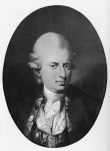Johann Friedrich Graf von Struensee (John Frederick Count of Struensee)
Christoph WernerTranslated by Christoph Werner (Weimar, Thuringia), edited by Michael Leonard (Petaluma, California)
There are many examples of persons of ordinary origin who tried their luck at the courts of kings or princes, particularly in the age of absolutism, and often had to suffer dire consequences. Agnes Bernauer, the daughter of a barber-surgeon may serve as an early example. She was drowned in the Danube near the town of Straubing in 1435 because the father of her lover Albert, later Duke Albert III of Bavaria, considered this liaison with a commoner unbefitting his son's social standing and arranged to have Agnes condemned for witchcraft.
The daughter of a school headmaster and organist, Dorothea Elisabeth Ritter happened to be involved in the conflict between Frederick William I, the Soldier King, and his son, later King Frederick the Great. Completely innocent of what she was accused, namely having helped the crown prince to desert, she was sentenced to be whipped in public and to spend the rest of her life in the spinning-house in Spandau. Before that she had to undergo a virginity test, which for a 16-year-old girl was particularly humiliating, to find out whether she had been intimate with the prince. She could consider herself lucky that she was set free after three years in the spinning-house.
Everybody knows Joseph Ben Issachar Süsskind Oppenheimer and his fate, which was described by Lion Feuchtwanger in his historical novel "Jud Süss". The cavalier was the Court Jew and financial adviser to Duke Karl Alexander of Württemberg and was executed after his lord's death in 1738, clearly the victim of a judicial murder.
Grigory Yefimovich Rasputin was a Siberian peasant who was an influential favourite at the court of Emperor Nicholas II and Empress Alexandra in St. Petersburg. He was murdered by a group of conservatives, among them relatives of the Czarist family. Among other things he was blamed for the catastrophical Russian conduct of war.
A particularly tragic fate is that of Johann Friedrich Graf von Struensee (John Frederick Count of Struensee), 1737-1772. He was born as the son of the Pietist minister Adam Struensee in Halle on the Saale. He attended the Latina (Grammar School) of the Francke Foundations and began the study of medicine at only 14 years old. In 1757 he became town physician in Altona, then an independent city west of Hamburg, which at that time was governed by Denmark. Here he wrote the scientific paper "A treatise about the nature of the cattle-plague and ways to heal it" ("Versuch von der Natur der Viehseuche und der Art sie zu heilen“). This was the first medical description of the foot-and-mouth disease.
Through his acquaintance with members of the Danish royal court he was offered the opportunity to accompany the Danish king Christian VII on his European tour (1768-69). Then he became personal physician to the king. He dominated the oversensitive – some say weak-minded and mentally disturbed – king, who entrusted him with all state affairs. In 1771 he became privy Cabinet minister and was awarded the title of count. From March 1771 to January 1772 he introduced a number of reforms that made Denmark for a short period the most progressive country in Europe. Among the reforms were freedom of the press, reduction of peasant labor service, a unitary judiciary, reform of Copenhagen's municipal government, abolition of torture, capital punishment and slave trade in the Danish colonies. Hardly any of these well-meant measures however survived their creator. His progressive ideas, his speedy advance at Court and his romance with the queen, which was probably tolerated or even encouraged by the king, produced for him many enemies. They succeeded in carrying out a putsch, in the course of which the king was persuaded to order Struensee's arrest. In a secret trial he was sentenced to death though he had been able to refute all the arguments of his opponents. On April 28th, 1772 this great and unhappy son of the city of Halle was beheaded, quartered and wheeled after the executioner had chopped off his right hand.
His memory is still alive in Denmark. Paul Barz (see recommended reading) cites a Copenhagen tourist guide as follows:
On the Osterfeld the farmers drove their cattle,
and also many people were beheaded here,
among them the famous Dr. Struensee.
He was the archiator of the king and lover of the queen.
That's what happens!
History's irony has it that the presumed daughter of Struensee and the Danish queen became the great-grandmother of the wife of Emperor William II, Auguste Viktoria von Schleswig-Holstein-Sonderburg-Augustenburg (1858–1921) .
Recommended reading:
Barz, Paul. 1989. Doktor Struensee. Rebell von oben. Berlin, Frankfurt a.M: Ullstein Sachbuch.




